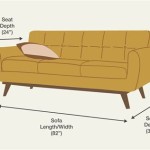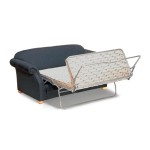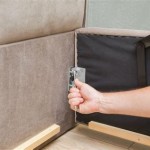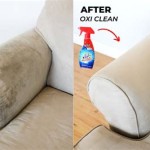How To Patch a Leather Sofa
Leather sofas, with their timeless elegance and durability, often become cherished pieces of furniture. However, accidents happen, and tears, scratches, or burns can mar their surface. Fortunately, patching leather is often possible, allowing one to restore the sofa's appearance without requiring complete reupholstery. This article provides a comprehensive guide to patching leather sofas, covering various methods and materials.
Assessing the Damage
Before attempting any repairs, a thorough assessment of the damage is crucial. This assessment determines the appropriate repair method and the necessary materials. Consider the following points:
- Size of the damage: Small holes or scratches can often be addressed with simple fillers or adhesives. Larger tears may require patching.
- Depth of the damage: Surface scratches may only require cosmetic treatment, while deeper cuts might necessitate filling and patching.
- Type of leather: Different leather types (aniline, pigmented, semi-aniline, etc.) react differently to repair materials. Identifying the specific leather type ensures compatibility.
Gathering the Necessary Materials
Once the damage is assessed, gather the appropriate materials. Having everything readily available streamlines the repair process. The necessary materials may include:
- Leather repair kit: These kits typically contain adhesive, filler, color-matching compounds, and application tools.
- Leather patch: If the damage is substantial, a leather patch is necessary. Choose a patch that closely matches the sofa's color and texture.
- Scissors: Sharp scissors are essential for cutting the patch to the correct size and shape.
- Tweezers: Tweezers can be helpful for manipulating small patches or applying filler.
- Rubbing alcohol: Cleaning the damaged area with rubbing alcohol ensures proper adhesion of the repair materials.
- Soft cloths: Clean cloths are needed for applying and removing cleaning and repair materials.
- Heavy object (optional): A heavy object, such as a book, can be used to apply pressure to the patch while the adhesive dries.
Cleaning the Damaged Area
Cleanliness is vital for a successful leather repair. Dirt and oils can interfere with the adhesion of repair materials. Follow these cleaning steps:
- Dampen a soft cloth with rubbing alcohol: Ensure the cloth is not soaking wet, but merely damp.
- Gently clean the damaged area and the surrounding leather: Remove any dirt, dust, or oil residue.
- Allow the area to dry completely: Before proceeding with the repair, ensure the leather is thoroughly dry.
Applying the Patch (If Necessary)
For larger tears or holes, a leather patch offers the best solution. Careful application of the patch ensures a seamless repair.
- Cut the patch to size: Cut the patch slightly larger than the damaged area, ensuring a sufficient overlap.
- Apply adhesive to the underside of the patch: Follow the manufacturer's instructions regarding adhesive application.
- Carefully position the patch over the damaged area: Ensure the patch aligns with the grain of the leather.
- Apply pressure to the patch: Use a heavy object, such as a book, to apply even pressure while the adhesive dries.
- Allow the adhesive to dry completely: Follow the manufacturer's instructions for drying time.
Filling the Damaged Area
Whether or not a patch is used, filling the damaged area is often necessary to create a smooth, even surface. Leather filler is specifically designed for this purpose.
- Apply the leather filler to the damaged area: Using a spatula or other application tool, carefully apply filler to the damaged area, ensuring it fills the hole or tear completely.
- Smooth the filler: Using the application tool, smooth the filler to create a seamless transition with the surrounding leather.
- Allow the filler to dry completely: Follow the manufacturer's instructions for drying time.
- Sand the filler (if necessary): Once the filler is dry, lightly sand it with fine-grit sandpaper to create a smooth, even surface.
Color Matching and Sealing
After the filler has dried and been sanded, the final step is to blend the repair with the surrounding leather. Color-matching compounds and sealants help achieve a seamless finish.
- Apply the color-matching compound: Carefully apply the compound to the repaired area, blending it seamlessly with the surrounding leather. Follow the manufacturer's instructions for application.
- Allow the compound to dry: Once the color match is satisfactory, allow the compound to dry completely.
- Apply a leather sealant (optional): A leather sealant protects the repaired area and helps to restore the leather's original sheen.
Alternative Repair Methods for Minor Damage
For very minor scratches or scuffs, simpler methods might suffice. These methods avoid the need for patches or fillers.
- Leather conditioner: Applying a high-quality leather conditioner can often minimize the appearance of minor scratches and scuffs.
- Leather recoloring balm: For minor discoloration, a leather recoloring balm can restore the leather's original color.

Fix A Rip In Your Leather Sofa Design Inkarnation Art And The Human Condition

Brown Leather Repair Patch Self Adhesive Couch Soft

Sofa Repairs With Leather Stitching Wefixanysofa Com

Leather Couch Repair 5 Best Methods Lounge Guys

Gallery Mastaplasta Repair Patches Leather Best Sofa Furniture

How To Fix Ling Leather All About Bonded Faux Chair Couch Repair

How To Blaze Leather Sofa Set Repairing Repair Making Process

Leather Furniture Repair Couch Chair Restoration

How To Repair A Leather Couch Expert Tips And Tricks

How To Repair A Leather Couch With Diy Tactics Home Of Cozy








